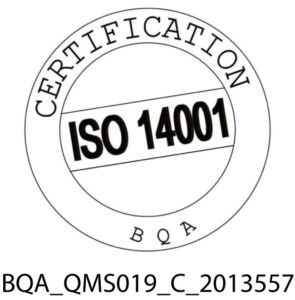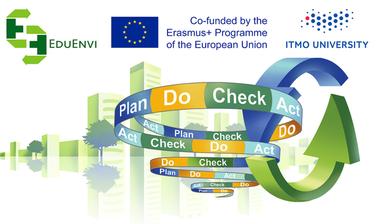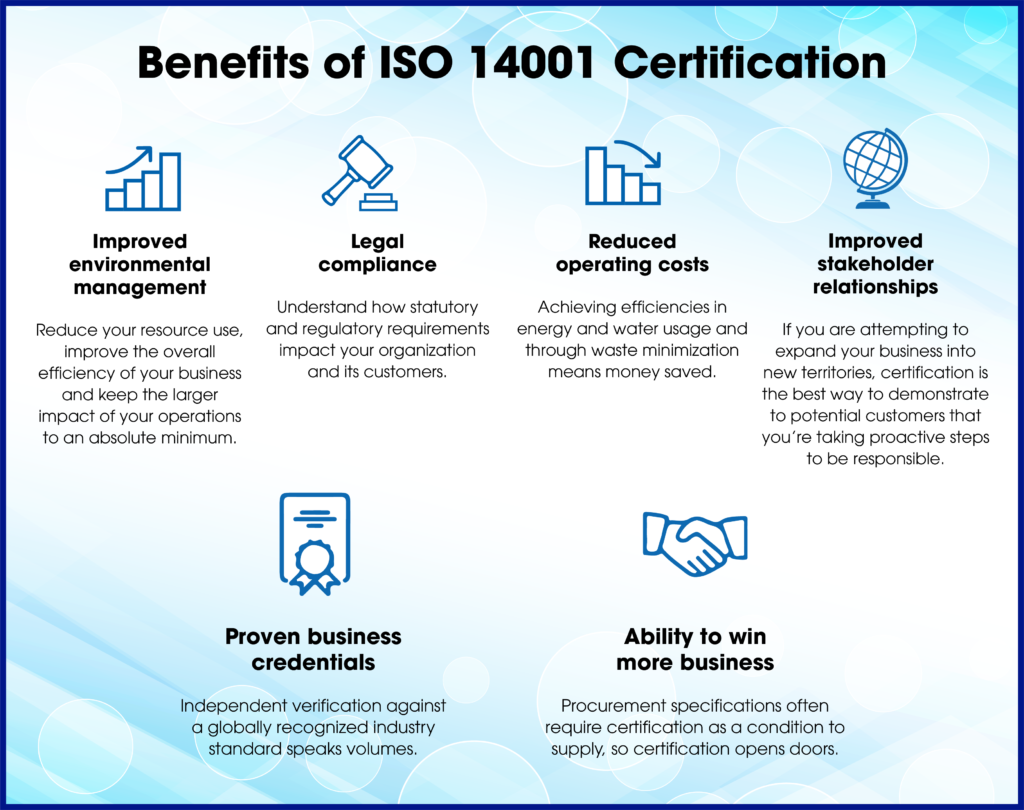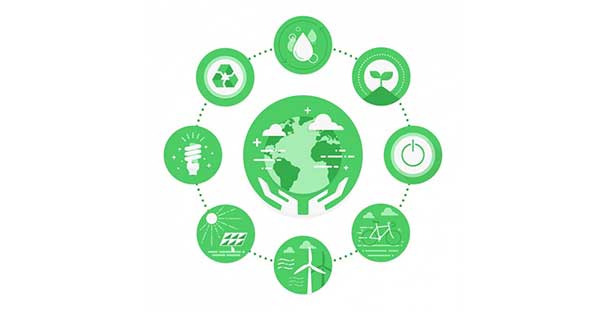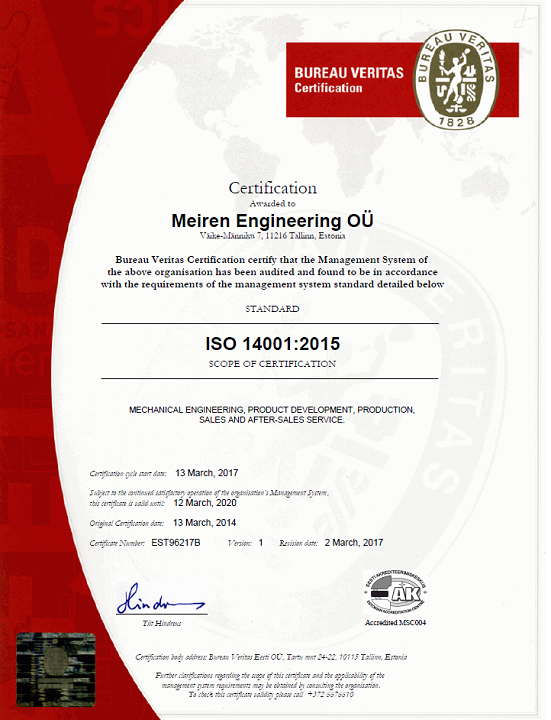What is ISO 14000? Definition & Standards Family for Environmental Management Systems (EMS)


Family of ISO standards ISO 14000 is a family of standards related to that exists to help organizations a minimize how their operations processes, etc. What are the simple basics of ISO 14001? Managing documentation for both standards in a single document control system• To implement policies relevant to environmental aspects• Its development was originally based on the Canadian Handbook for Accountants; it is now based on an international accounting standard. Providing adequate resources• What is environmental management? Statistics straight from the most recent. This review assists the organization in establishing their environmental objectives, goals, and targets which should ideally be measurable ; helps with the development of control and management procedures and processes; and serves to highlight any relevant legal requirement, which can then be built into the policy. seek confirmation of its self-declaration by a party external to the organization, or• ISO has a neutral policy on conformity assessment in so much that one option is not better than the next. Continual Improvement Process CI [ ] ISO 14001 encourages a company to continually improve its environmental performance. The current version is ISO 14001:2015, and certified organizations were given a three-year transition period to adapt their environmental management system to the new edition of the standard. Using ISO 14001 can provide assurance to company management and employees as well as external stakeholders that environmental impact is being measured and improved. Providing a framework for using pollution prevention practices to meet EMS objectives. An effective EMS can refrain the firm from using hazardous materials and pollutants. The organization must meet the environmental expectations of customers and the government, and it must incorporate environmental management elements into internal audit programs and training sessions. "Green Clubs and Voluntary Governance: ISO 14001 and Firms' Regulatory Compliance". Expansion: Business areas increasingly get covered by the implemented EMS. This is not an acceptable reference under ISO terms and definitions, as it can lead to confusion in the market. To change or withdraw your consent choices for Investopedia. Option three is an independent third-party process by an organization that is based on an engagement activity and delivered by specially trained practitioners. Upgrading: The structural and organizational framework of the EMS, as well as an accumulation of knowledge in dealing with business-environmental issues, is improved. Training in the concepts of ISO 14001 is available, and there are a range of course options for individuals to choose from. Certification is valid for three years and is maintained through a programme of annual surveillance audits and a three yearly recertification audit. Data taken from What is an environmental management system? ISO 14001 — Environmental Management Environmentalism should be one of the primary corporate motives today. These recommendations are incorporated through continual improvement: plans are renewed or new plans are made, and the EMS moves forward. For more on how this works within the ISO 14001 standard, this blog article gives a more detailed explanation:. It is as brief as:• ISO 14001:2015 is not a technical standard, and as such, does not in any way replace technical requirements embodied in statutes or regulations. An environmental management system is a framework for making policy and process changes that help you improve your environmental performance. As of 2017 , more than 300,000 certifications to ISO 14001 can be found in 171 countries. These pose threats to life, property, economic well-being and to ecosystems. It also includes several new updates all aimed at making environmental management more comprehensive and relevant to the supply chain. Expansion in EMS coverage and scope• The certification is broad enough to offer significant benefits to organizations in any industry or sector, while still providing a specific framework for implementing relevant sustainable practices. If you have any questions or suggestions regarding the accessibility of this site, please. "Case studies of ISO 14001: A new business guide for global environmental protection". Leadership• Promoting Environmental Management Systems with ISO 14000 The primary objective of the ISO 14000 series of standards is to promote effective environmental management systems in organizations. New documentation requirements• However, the ISO 14001 requirements provide a framework and guidelines for creating your environmental management system so that you do not miss important elements needed for an EMS to be successful. International Organization for Standardization. As part of the effort to structure all ISO standards in the same way, the ISO 14001:2015 revisions include incorporating a required high-level structure, using mandatory definitions, and incorporating common standards requirements and clauses. BS 7750 supplied the template for the development of the ISO 14000 series in 1996, which has representation from ISO committees all over the world. ISO 14006:2011 - Environmental Management Systems - Guidelines For Incorporating Ecodesign• What do the standards in the ISO 14000 family cover? The standard is published by ISO the International Organization for Standardization , an international body that creates and distributes standards that are accepted worldwide. You will receive both a hard and soft copy of the certificate. ISO 14040 to 14049 Environmental management - ; discusses pre- and environment goal setting• This research concluded that ISO 14001 registration can be leveraged across the supply chain for competitive advantage. With a wealth of experience providing accredited management systems certifications, NQA is ideally placed to partner with you to meet stakeholder requirements and exceed industry expectations. American Journal of Political Science. By engaging your employees in a group effort to reduce your environmental footprint you can increase employee focus and retention. We are committed to ensuring that our website is accessible to everyone. Improve overall environmental impact• Engage your people — Given a choice between working for a company that shows care and concern for the environment around it and one that does not, most people would prefer the first company. Below are the results over the previous 6-year period. Context of the organization• ISO 14001 can also be integrated with other management functions and assists companies in meeting their environmental and economic goals. The fourth option, certification, is another independent third-party process, which has been widely implemented by all types of organizations. For a full list of published standards in the series see their. Other procedures are required to foster better management control over elements such as documentation control, emergency preparedness and response, and the education of employees, to ensure that they can competently implement the necessary processes and record results. " The ISO 14000 series is based on a voluntary approach to environmental regulation. Thirdly, there has been a push in the last decade by consumers for companies to adopt better internal controls, making the incorporation of ISO 14001 a smart approach for the long-term viability of businesses. ASQ celebrates the unique perspectives of our community of members, staff and those served by our society. Secondly, as an internationally recognized standard, businesses operating in multiple locations across the globe can leverage their conformance to ISO 14001, eliminating the need for multiple registrations or certifications. These can be one- or two- or even five-day courses, and can even include online e-learning sessions as a method of teaching the material. ISO 14001 and EMAS [ ] In 2010, the latest Regulation EMAS III entered into force; the scheme is now globally applicable, and includes key performance indicators and a range of further improvements. It is a structured approach to define environment oriented goals and help organizations to pursue them. The new standard also requires the holder of the certificate to specify risks and opportunities and how to address them. Improvements in overall environmental performance and compliance. Books Articles and Case Studies Quality Management Journal Environmental sustainability has gained momentum in the business world and academia. There are more than 300,000 certifications to ISO 14001 in 171 countries around the world. It delivers a planned approach towards complying the legal obligations in relevance to environmentalism. Create a personalised content profile. The first three are introductory, with the last seven containing the requirements for the environmental management system. "BS 7750 and environmental management". An EMS is defined by ISO as: "part of the overall management system, that includes organizational structure, planning activities, responsibilities, practices, procedures, processes, and resources for developing, implementing, achieving, and maintaining the environmental policy. Enhancing public posture with outside stakeholders. Review existing quality management system requirements• These sections are based on a Plan-Do-Check-Act cycle, which uses these elements to implement change within the processes of the organization in order to drive and maintain improvements within the processes. This option was based on an accounting procedure branded as the EnviroReady Report, which was created to help small- and medium-sized organizations. Because ISO 14001:2015 is essentially a system designed to help communities and other types of organizations meet their environmental obligations and reduce the impact of their operations on the environment, it is relevant to all types of organizations. It can be used by any organization that wants to improve resource efficiency, reduce waste, and reduce costs. Any use, including reproduction requires our written permission. Improve resource efficiency• In a survey of ISO 14001 certification at the end of 2017 the number of companies that have implemented an ISO 14001 environmental management system shows a stable trend worldwide. Environmental management - Environmental performance evaluation - Guidelines• Risks and opportunities of the EMS in the organization need to be assessed, and environmental objectives for improvement need to be identified and plans made to accomplish these objectives. original equipment manufacturers and their suppliers Year Edition 1996 1st Edition 2004 2nd Edition 2015 3rd Edition ISO 14001:2015 [ ] All standards are periodically reviewed by ISO to ensure they still meet market requirements. When a culture of improvement is created, people are always looking for ways to make their processes better, which makes maintaining the EMS easier. As with ISO 9000, ISO 14000 acts both as an internal management tool and as a way of demonstrating a company's environmental commitment to its customers and clients. This includes establishing procedures and processes, although only one documented procedure is specifically related to operational control. What is ISO 14001 certification? Establishing a program to periodically audit the operation of the EMS. It maps out a framework that a company or organization can follow to set up an effective environmental management system. What does ISO 14001 actually look like? This overview guide is here for you to learn the basics of ISO 14001, help you to discover what the ISO 14001 requirements are, and to give you a guide on what needs to be done to implement an environmental management system and become certified. This includes:• These could be incorporated into the overall EMS under ISO 14001:2015. Environmental Quality Management. Counties, municipalities, towns, and townships typically oversee a number of separate facilities and operations. ISO promotes the development and implementation of voluntary international standards, both for particular products and for environmental management issues. Management review — A formal review by your management to evaluate the relevant facts about the management system processes in order to make appropriate decisions and assign resources. For example, many organizations, including counties and municipalities, have active and effective pollution prevention activities underway. The EMS can help with this by conserving energy and input materials, while reducing incidents for which a company can incur liability costs and improved environmental controls can help to obtain insurance at reduced costs to the company. Use of the standard by counties is not well established at this point, but some are beginning to use it. For example, Washtenaw County, Michigan is implementing an EMS based on ISO 14001 for its Sheriff's Department and participated in an earlier series of demonstration projects funded by EPA. Other standards in the family focus on specific approaches such as audits, communications, labelling and life cycle analysis, as well as environmental challenges such as climate change. "ISO 14001 and the Reduction of Toxic Emissions". Nearly any business can benefit from achieving certification to ISO 14001 standards. creating multi-annual comparability within and between organizations• , prevention of pollution, continual impovement, and compliance. Do: Planning is incomplete unless it has been put in place. ISO 14001 Environmental management systems - Requirements with guidance for use• is the most popular standard of the ISO 14000 family, which also includes the following standards:• This can bring better relationships with customers, the public, and the community at large for your company, but it also brings other benefits. Kontinuierliche Verbesserung im Umweltmanagement: Die KVP-Forderung der ISO 14001 in Theorie und Unternehmenspraxis. refers to a series of voluntary standards in the environmental field under development by ISO. increasingly get managed by the implemented EMS. The adopting organization decides which option is best for them, in conjunction with their market needs. "Corporate Greening Through ISO 14001: A Rational Myth? The first environmental management system standard, BS 7750, was published in 1992 by the. If all the elements of ISO 14001 are incorporated into the management process, the organization may opt to prove that it has achieved full alignment or conformity with the international standard, ISO 14001, by using one of four recognized options. all industry sectors, including public and private sectors• Check: Measure and monitor the processes and report results [ ] During the "check" stage, performance is monitored and periodically measured to ensure that the organization's environmental targets and objectives are being met. Can existing environmental management activities be integrated into the EMS under ISO 14001? Used under licence of AXELOS Limited. It can increase a business's access to new customers and business partners. An efficient EMS enables organizations:• Certification is also known in some countries as registration. Additionally, the review evaluates changing circumstances, such as legal requirements, in order to make recommendations for further improvement of the system. government supervision of the environmental verifiers• The series includes the ISO 14001 standard, which provides guidelines for the establishment or improvement of an EMS. It provides a framework that an organization can follow, rather than establishing environmental performance requirements. To learn more about ISO 14001 implementation, please visit our page. However, this premise needs to be evaluated closely, working with a variey of organizations, including those in the public sector. Another significant change linked ISO 14001 to the general management system structure, introduced in 2015, called the High Level Structure. The current version of ISO 14001 is ISO 14001:2015, which was published in September 2015. Like a number of states, EPA believes environmental management systems, if implemented properly, could serve as a valuable tool to help organizations improve their environmental peformance, increase the use of pollution prevention, and improve compliance. How does the ISO 14001 EMS work? ISO 14001 and Beyond: Environmental Management Systems in the Real World. We will use this information to accurately define your scope of assessment and provide you with a proposal for certification. Purchase• ISO 14063 Environmental management - Environmental communication - Guidelines and examples• -Anti-bribery management systems• Quality Engineering Questions regarding implementation of ISO 14001 prompted NP Power, the electric power company of New Brunswick, Canada, to develop a framework to assess its compliance to the standards. These are:• ISO 14001 aims at encouraging organizations to promote concern towards the sustained environment. The user is responsible for making their own determination. To mention a few, the scope of systems; the nature of business activities involved, the nature of products and services delivered, the industry to which a firm belongs etc, are all matter of facts that make difference towards the working of this standard. ISO does not control conformity assessment; its mandate is to develop and maintain standards. Why should you implement ISO 14001 in your organization? Improve cost control — One improvement that all companies are looking for is reduction of costs. single-site to large multi-national companies• By doing this, you will be able to collect the records necessary to go to the next steps: auditing and reviewing your system and becoming certified. Each option serves different market needs. Increased efficiency and potential cost savings when managing environmental obligations. Archived from on 7 August 2017. To develop considerations and accountability for legal requirements relevant to environment• The standards specify requirements for establishing an , determining environmental impacts of products or services, planning environmental objectives, implementing programs to meet objectives, and conducting corrective action and management review. It is a management tool that aids any firm, irrespective of size, sector or type, to identify and to control the impact of its activities, its products and services on the environment. The organization sets its own targets and performance measures, and the standard highlights what an organization needs to do to meet those goals, and to monitor and measure the situation. mandatory provision of information to the general public• All the ISO standards are developed through a voluntary, consensus-based approach. ISO 14001:2015 should be used by any organization that wishes to set up, improve, or maintain an environmental management system to conform with its established environmental policy and requirements. This improvement in cost control is a benefit that cannot be overlooked when making the decision to implement an environmental management system. ISO 14001, like other ISO 14000 standards, is voluntary, with its main aim to assist companies in continually improving their environmental performance and complying with any applicable legislation. Looking to implement an ISO 14001 management system? Meet legal obligations• Is an EMS under ISO 14001 relevant to communities? This section discussed the steps for a company to implement an ISO 14001 environmental management system and have it certified. The standard shares many common traits with its predecessor, ISO 9000, the international standard of quality management, which served as a model for its internal structure, and both can be implemented side by side. EMAS's structure and material are more demanding, mainly concerning performance improvement, legal compliance, and reporting duties. What are the practical steps to becoming ISO 14001 certified? The standards seek to provide cost-effective tools that make use of best practices for organizing and applying information about environmental management. This assessment consists of two mandatory visits that form the Initial Certification Audit. Collectively, we are the voice of quality, and we increase the use and impact of quality in response to the diverse needs in the world. Develop relevant objectives and processes. Need to remain socially responsible and environmentally friendly, simultaneously, are also essential pre-requisite for a firm to indicate its concern towards the social good. The course includes an exam at the end to verify knowledge and competence, and it is only with an accredited course that an individual can become approved to audit for a certification body. ISO 14001:2015 is relevant to all organizations, regardless of size, location, sector, or industry. With different organizational approaches to environmental management, comparisons of systems and collaboration had proved difficult. These courses are good for those who need an overview on the ISO 14001 standard, or those who will be involved in the implementation within a company, and many are more economical than investing in the lead auditor course for those involved at this level. To get started with ISO 14001:2015:• This will lead to increased profits, improved relations with stakeholders and a good corporate image amidst the society. Section 8: Operation — The operation requirements deal with all aspects of the environmental controls needed by the organizational processes, as well as the need to identify potential emergency situations and plan responses so that you are prepared to respond should an emergency occur. cause adverse changes to air, water, or land ; b comply with applicable laws, regulations, and other environmentally oriented requirements; and c continually improve in the above. Planning• Get• ISO 14001 has become the international standard for designing and implementing an environmental management system. This is why many organizations seek an environmental management system. Act: Take action to improve performance of EMS based on results [ ] After the checking stage, a management review is conducted to ensure that the objectives of the EMS are being met, the extent to which they are being met, and that communications are being appropriately managed. How are these standards developed? One of the biggest benefits of implementing an EMS is the recognition that comes with being among those businesses that care enough to reduce their environmental footprint. Complementarities and differences [ ] ISO 14001's EMS requirements are similar to those of EMAS. ISO 14004:2016 - Environmental Management Systems - General Guidelines On Implementation• Impacts on the internal audit program• Organizations will have a three-year transition period to update their environmental management systems to the new standard. Undertaking periodic reviews of the EMS by top management to ensure its continuing performance and making adjustements to it, as necessary. The current revision of ISO 14001 was published in September 2015. ISO 14001 is the international standard for environmental management systems EMS and the most widely used EMS in the world, with over 360,000 ISO 14001 certificates issued globally. See also: In March 1992, published the world's first environmental management systems standard, BS 7750, as part of a response to growing concerns about protecting the environment. Need for risk-based planning and controls• Certify to ISO 14001 With members and customers in over 130 countries, ASQ brings together the people, ideas and tools that make our world work better. Getting to the heart of why ISO 14001 is important Taking care of our environment, and preventing our companies from causing negative impacts on the environment, are two of the most important challenges facing businesses today. There are many ways to go about implementing an across-the-board environmental management policy, but the best way is to become certified to ISO 14001. Designed for any type of organization, regardless of its activity or sector, it can provide assurance to company management and employees as well as external stakeholders that environmental impact is being measured and improved. Archived from PDF on 28 July 2011. Included in the ISO 14000 series are the ISO 14001:2015 Environmental Management System EMS standard and other standards in fields such as environmental auditing, environmental performance evaluation, environmental labeling, and life-cycle assessment. The EMS and auditing standards were recently revised and published in September 2015. Why Environment management systems EMS? Using ISO 14001:2015 has many benefits for organizations with environmental management systems. Section 5: Leadership — The leadership requirements cover the need for top management to be instrumental in the implementation of the EMS. What must a community do to have an EMS that meets the ISO 14001 standard? It does not state requirements for environmental performance but rather maps out a framework that a company or organization can follow to set up an effective EMS. Promoting predictability and consistency in managing environmental obligations. Integral to the model is the concept of continual improvement of the EMS. Other standards in this series include ISO 14004, which gives additional guidelines for a good EMS, and more specialized standards dealing with specific aspects of environmental management.。 。


